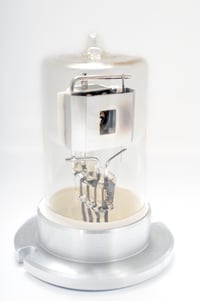What Is a Light Source within UV-Vis Spectroscopy?
Here you can learn more about the deuterium and tungsten-halogen light sources within UV-Vis Spectroscopy.
Light, as electromagnetic radiation, spans a spectrum from ultraviolet (UV) to infrared (IR). Within UV-Vis spectroscopy, understanding the nature and types of light sources is important, as they directly influence the accuracy and reliability of measurements.
Monochromatic vs. White Light Sources
-
Monochromatic Light Sources:
- Definition: These sources emit radiation at a specific, singular wavelength (frequency). Unlike white light, which is a composite of multiple wavelengths, monochromatic light has a defined emission profile.
- Creation: Natural occurrences of monochromatic light sources are limited, necessitating artificial production. Generating monochromatic light involves the excitation of electrons using appropriate energy sources. Upon recombination, these electrons release energy in the form of monochromatic light.
- Examples: Lasers, electroluminescent diodes (LEDs), and fluorescent lamps are common monochromatic light sources.
-
White Light Sources:
- Definition: These sources emit a combination of various wavelengths within a specific range. Optical instruments, such as prisms or diffraction gratings, can separate this composite light into its constituent wavelengths.
- Origin: White light predominantly arises from thermal sources, where the illumination process involves heating solid materials.
- Examples: Stars, bulbs, arc lamps, and halogen lamps are typical thermal sources producing white light.
Light Sources in UV-Vis Spectrophotometry
The selection of an appropriate light source is crucial in UV-Vis spectroscopy. The light source should ideally exhibit consistent intensity across all wavelengths. However, achieving this consistency is challenging.
When utilizing lamps in UV-Vis spectroscopy, users should be vigilant about potential variations in light output due to the lamp's natural wear and external factors. Regular calibration and maintenance are essential to counteract the effects of lamp degradation, temperature changes, and electrical inconsistencies, ensuring accurate and consistent measurements.
Two primary sources dominate this field:
-
Deuterium Arc Lamp: This lamp offers a continuous intensity in both the UV and visible regions. Modern versions are designed to minimize noise, enhancing instrument performance. However, the intensity from a deuterium arc lamp may decrease with prolonged use.

-
Tungsten-Halogen Lamp: Characterized by its high intensity across a significant portion of the UV spectrum and the entire visible range, this lamp is known for its low noise and stability. Many spectrophotometers incorporate both lamp types, either alternating between them or combining their emissions to produce a comprehensive light source.
Conclusion
In UV-Vis spectroscopy, the choice of light source is integral to the accuracy and reliability of measurements. The distinction between monochromatic and white light sources, and their specific roles in this field, highlights the importance of understanding their characteristics and applications. As research and technology progress, the optimization of light sources for UV-Vis spectroscopy remains a critical area of focus.
Tip:
Interested in how you can upgrade your existing UV-Vis spectrophotometers and easily streamline and automate your data analysis? Learn more here.
References
- Monochromatic Light
- White Light Sources
- Owen, Tony. "Fundamentals of modern UV-visible spectroscopy." Agilent Technologies, 2000.